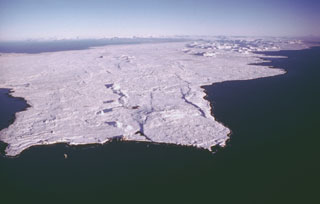Report on Reykjanes (Iceland) — 4 September-10 September 2024
Smithsonian Institution / US Geological Survey
Weekly Volcanic Activity Report, 4 September-10 September 2024
Managing Editor: Sally Sennert.
Please cite this report as:
Global Volcanism Program, 2024. Report on Reykjanes (Iceland) (Sennert, S, ed.). Weekly Volcanic Activity Report, 4 September-10 September 2024. Smithsonian Institution and US Geological Survey.
Reykjanes
Iceland
63.817°N, 22.717°W; summit elev. 140 m
All times are local (unless otherwise noted)
IMO reported that the eruption between Stóra-Skógfell and Sundhnúkur, within the Reykanes volcanic system, had ended after 14 days. During 1-5 September activity was concentrated at two main vents located at the N end of the fissure but the intensity of the activity had significantly decreased. Seismic activity had also decreased along with gas emissions. Lava continued to slowly move N, thickening the flow field. Activity at the vents was no longer visible by the evening of 5 September. On 6 September IMO lowered the Aviation Color Code to Yellow (the second lowest level on a four-color scale) noting that the eruption was over. Volcanic tremor had decreased almost to pre-eruptive levels. GPS data indicated that inflation at Svartsengi had resumed.
Geological Summary. The Reykjanes volcanic system at the SW tip of the Reykjanes Peninsula, where the Mid-Atlantic Ridge rises above sea level, comprises a broad area of postglacial basaltic crater rows and small shield volcanoes. The submarine Reykjaneshryggur volcanic system is contiguous with and is considered part of the Reykjanes volcanic system, which is the westernmost of a series of four closely-spaced en-echelon fissure systems that extend diagonally across the Reykjanes Peninsula. Most of the subaerial part of the system (also known as the Reykjanes/Svartsengi volcanic system) is covered by Holocene lavas. Subaerial eruptions have occurred in historical time during the 13th century at several locations on the NE-SW-trending fissure system, and numerous submarine eruptions dating back to the 12th century have been observed during historical time, some of which have formed ephemeral islands. Basaltic rocks of probable Holocene age have been recovered during dredging operations, and tephra deposits from earlier Holocene eruptions are preserved on the nearby Reykjanes Peninsula.
Sources: Icelandic Meteorological Office (IMO), National Commissioner of the Icelandic Police (NCIP) Department of Civil Protection and Emergency Management

